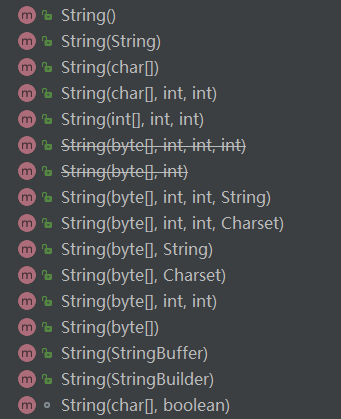String 类也是java.lang 包下的一个类,算是日常编码中最常用的一个类了,那么本篇博客就来详细的介绍 String 类。
1、String 类的定义
public final class String
implements java.io.Serializable, Comparable<String>, CharSequence {}
和上一篇博客所讲的 Integer 类一样,这也是一个用 final 声明的常量类,不能被任何类所继承,而且一旦一个String对象被创建, 包含在这个对象中的字符序列是不可改变的, 包括该类后续的所有方法都是不能修改该对象的,直至该对象被销毁,这是我们需要特别注意的(该类的一些方法看似改变了字符串,其实内部都是创建一个新的字符串,下面讲解方法时会介绍)。接着实现了 Serializable接口,这是一个序列化标志接口,还实现了 Comparable 接口,用于比较两个字符串的大小(按顺序比较单个字符的ASCII码),后面会有具体方法实现;最后实现了 CharSequence 接口,表示是一个有序字符的集合,相应的方法后面也会介绍。
2、字段属性
/** The value is used for character storage. */ private final char value[]; /** Cache the hash code for the string */ private int hash; // Default to 0 /** use serialVersionUID from JDK 1.0.2 for interoperability */ private static final long serialVersionUID = -6849794470754667710L;
一个 String 字符串实际上是一个 char 数组。
3、构造方法
String 类的构造方法很多。可以通过初始化一个字符串,或者字符数组,或者字节数组等等来创建一个 String 对象。

String str1 = "abc";//注意这种字面量声明的区别,文末会详细介绍 String str2 = new String("abc"); String str3 = new String(new char[]{'a','b','c'})
4、equals(Object anObject) 方法
instanceof 运算符 用于:判断 该运算符前面引用类型变量指向的对象是否是后面类,或者其子类、接口实现类创建的对象。如果是则返回true,否则返回false, 其使用格式如下: 引用类型变量 instanceof (类、抽象类或接口)
1 /** 2 * Compares this string to the specified object. The result is {@code 3 * true} if and only if the argument is not {@code null} and is a {@code 4 * String} object that represents the same sequence of characters as this 5 * object. 6 * 7 * @param anObject 8 * The object to compare this {@code String} against 9 * 10 * @return {@code true} if the given object represents a {@code String} 11 * equivalent to this string, {@code false} otherwise 12 * 13 * @see #compareTo(String) 14 * @see #equalsIgnoreCase(String) 15 */ 16 public boolean equals(Object anObject) { 17 if (this == anObject) { 18 return true; 19 } 20 if (anObject instanceof String) { 21 String anotherString = (String)anObject; 22 int n = value.length; 23 if (n == anotherString.value.length) { 24 char v1[] = value; 25 char v2[] = anotherString.value; 26 int i = 0; 27 //比较每一个字符的值 28 while (n-- != 0) { 29 if (v1[i] != v2[i]) 30 return false; 31 i++; 32 } 33 return true; 34 } 35 } 36 return false; 37 }
String 类重写了 equals 方法,比较的是组成字符串的每一个字符是否相同,如果都相同则返回true,否则返回false。